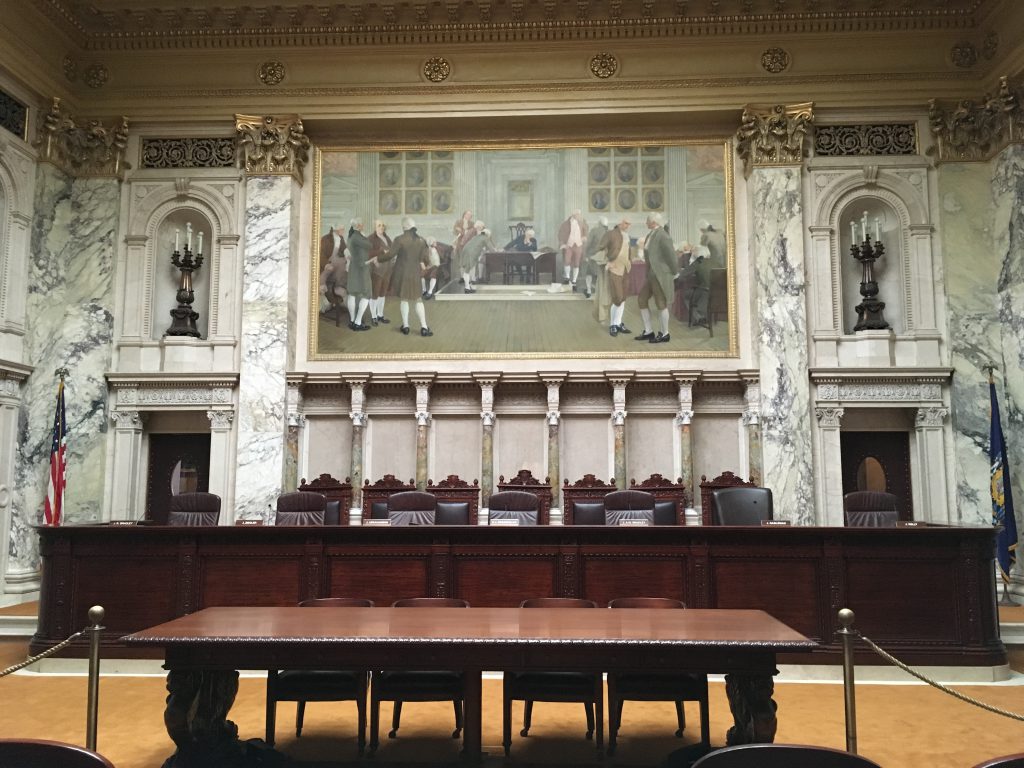Can State Be Redistricted Again?
State Supreme Court race could change majority view on one of worst gerrymanders in the nation.

Wisconsin Supreme Court. Photo by Mariiana Tzotcheva.
In the recent midterm election, Democrats won three of five statewide races, including two of the three most important, governor and attorney general.
But using their newly gerrymandered maps in 2022, Republicans expanded their large majorities in the state legislature, securing a 2/3 supermajority in the state Senate, and falling two seats short in the Assembly.
“One of the most successful gerrymanders in the country,” added Alisa Von Hagel, a political science professor at UW-Superior.
And UW-Madison political science professor Barry Burden said the midterm elections validated a troubling perception about the state of Wisconsin’s democracy.
“The 2022 election results have confirmed that the partisan makeup of the state legislature has little to do with voters’ preferences,” he said. “Despite all of the statewide elections being decided by narrow margins and slightly favoring Democratic candidates, large Republican majorities in the state legislature actually got larger.”
But big changes to the political districts in Wisconsin are still possible in the near future, experts say. The most crucial determining factor likely will come down to who wins next year’s election on April 4 for the open seat on the Wisconsin Supreme Court.
Wisconsin Supreme Court Election
When it was time to redraw the political districts in 2021, which states are required to do after the Census every ten years, Wisconsin state government was divided, as it remains today.
With a Democratic governor’s veto in place, the GOP-controlled legislature couldn’t pass their preferred maps, as they had in 2011, when Republican Scott Walker was the state’s executive.
So the 2021 redistricting saga landed in the courts, as it had several times in previous decades.
Those previous legal proceedings ended with the Wisconsin Supreme Court declining to rule on political district boundaries, leaving the map-making to the federal courts, which usually hired an expert to draw them with as little partisan skew as possible.
That approach is common in courts across the country, said Robert Yablon, an associate professor at the UW-Madison law school, who focuses on political and election law.
But it was “virtually unheard of” to enact a least change redistricting method when the previous maps, which would provide the basis for the new ones, had a strong partisan lean, as Wisconsin’s did, Yablon noted.
Ultimately, Wisconsin got state legislative maps that heavily favored Republicans, a point the election results validated.
But a win in the 2023 election by the liberal candidate for that open Wisconsin Supreme Court seat would flip the right-leaning 4-3 majority to a left-leaning one.
“Democrats and good government groups are hopeful that a change in the court’s ideological composition will provide an opportunity to challenge the current districts as partisan gerrymanders,” Burden said.
A newly configured court might be more willing to entertain litigation arguing that the previous round of redistricting was conducted illegally, and needs to be redone, Yablon said.
“I think there is a reasonable likelihood that that could happen if the composition of the court changes,” Yablon said.
If history is an indication, the U.S. Supreme Court would be unlikely to intervene in the Wisconsin Supreme Court decision. Although the U.S. high court intervened in 2022 in a case challenging Wisconsin’s maps on racial gerrymandering, the court repeatedly has declined to weigh in on political gerrymandering cases.
Whichever party wins the 2023 Wisconsin Supreme Court open seat, liberals will have to defend a seat in 2025, when the left-wing justice Ann Walsh Bradley is up for reelection. The seats of two other right-wing justices are up for reelection in 2026 and 2027.
One outcome appears certain, Burden said: Wisconsin Supreme Court races “will attract a ton of interest and money because the court has become the venue where so many of the most controversial issues in the state are settled.”
Other possible changes to Wisconsin’s political districts
In 2022, after a protracted battle in the state house and courts, the Wisconsin Supreme Court ultimately enacted state legislative maps drawn by Republicans. But those maps removed a majority Black district in the state Assembly. That could be legally problematic under the Voting Rights Act, which aims to protect discriminatory voting practices. It could present an opportunity to challenge the maps based on racial gerrymandering.
However, “given where the U.S. Supreme Court is now on these issues, that kind of case would probably be an uphill battle,” Yablon said.
The end of gerrymandering also could come from a Congress controlled by Democrats, who generally support enacting nonpartisan redistricting across the U.S. But Democrats must have large enough majorities in Congress to do that, and Republicans just gained a narrow majority in the House in the 2022 elections.
Another possible antidote to political gerrymandering exists in The Fair Representation Act, which would eliminate single-member districts and replace them with multi-member districts across the country, drawn by an independent commission. Introduced by U.S. Rep. Donald Beyer (D-VA), the bill also would launch ranked-choice voting, which allows voters to rank candidates based on their preference rather than voting for one. Maine and Alaska use the system, and Nevada has taken a big step towards using it.
The bill has no Republican sponsors, giving it a very low likelihood of passage in the near term.
The 2022 Election is over. Wisconsin turns to redistricting (again) was originally published by The Badger Project.

















I hope so. Republican tyranny has lasted to long.
Take a look at how bad the illinois maps are as well they are terrible.